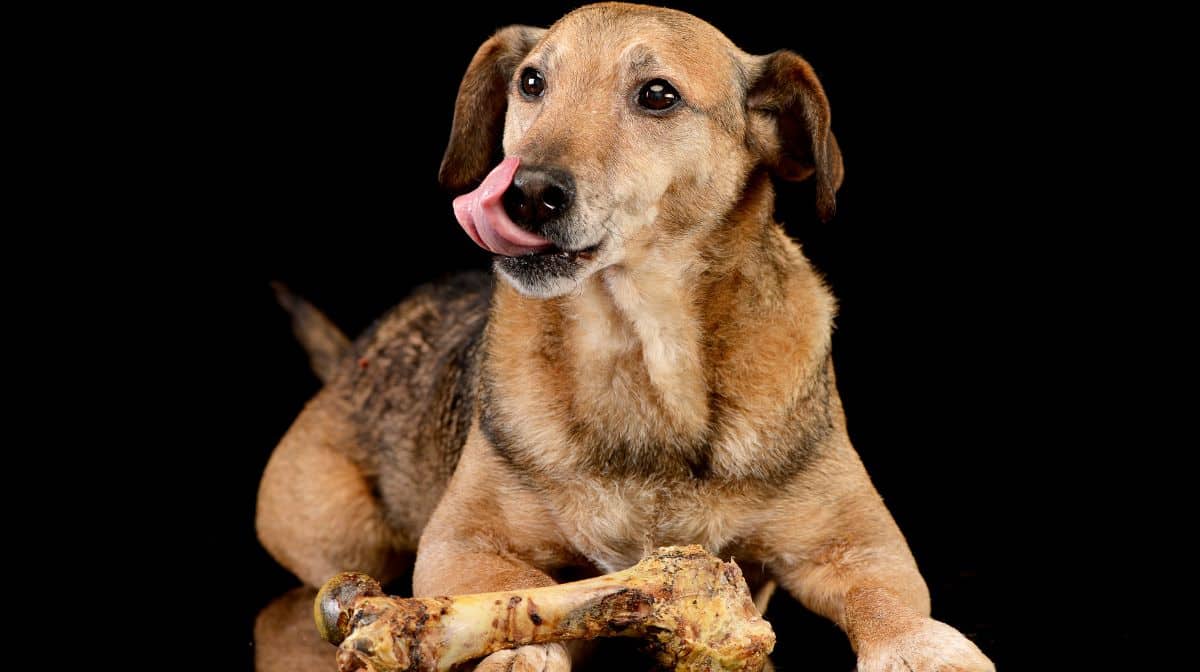How long can a dog survive without food? Do you know about this duration? Basically, the length of time a dog can survive without food largely depends on dog’s size, age and health condition. In general, healthy dog can survive without food for about 3 to 5 days.
Because of more fat reserves of young dog might survive slightly longer than smaller and senior dogs. Though this timing also depends on underlying health condition of senior dogs.
I am working in Upazila Veterinarian Hospital for last two years. For this reason, I get a chance to face this situation like starvation of dog for few days. In this article, I describe all of my practical experience for your consideration.

Factors Affecting a Dog’s Survival without Food
Here, I include some factors that can be considered to understand the factors for long time or less time surviving of dog without food.
Size and Breed: As larger dog have more fat reserves, it can survive longer than smaller dog. Indeed, different metabolic rates of small dogs quickly affect this timing.
Age: Due to developmental and metabolic needs, puppies and senior dogs are more vulnerable to starvation.
Health Condition: Pre-existing health conditions, malnutrition, or illnesses are another causes of less timing of starvation for dog.
Activity Level: Additionally, active dogs will burn calories faster. That’s way; they exhaust their energy reserves quicker in comparison less active dogs.
Access to Water: Hydration is another important factor to understand the length of time during starvation for your dogs. A dog without sufficient water cannot survive for long time.
Physiological Effects of Starvation in Dogs
Starvation in dogs leads to a series of physiological changes surely. Those physiological effects are precisely described here for your understanding.
Glycogen Depletion: Indeed, dog’s body first utilizes glycogen stores in the liver and muscles for energy during starvation. And these rapid depletion of glycogen lead to early fatigue and lethargy.
Fat Metabolism: After glycogen stores are exhausted, Dog’s body starts breaking down fat stores to produce energy. Consequently, it reduces weight and become thinner.
Protein Catabolism: Dogs stored fat deplete after few day, the body begins breaking down muscle tissue and proteins for energy. As a result, it loss of muscle mass, lead weakness, reduce mobility, weakens the immune system and make the dog more susceptible to infections.
Organ Failure: After several weeks without food, dog’s body’s protein and muscle breakdown that l leads to severe systemic failure. Finally, they face hypoglycemia, liver and kidney Failure, cardiovascular collapse and death.
Metabolic and Systemic Changes: After this, dogs feel lethargic and decreased physical mobility. Basically, starvation disrupts the balance of electrolytes that affect muscle function, nerve transmission, and overall cellular health. In addition to, digestive system slows down that influence negatively on mobility.
Psychological and Behavioral Effects: Increased Irritability, Anxiety, depression and apathy are the result of starvation.
Signs of Malnutrition and Starvation
You can easily identify the signs of Malnutrition and Starvation by observing the physical, clinical and behavioral sings in your dogs. Those are:
Weight Loss: Firstly, you notice the decreasing weight and muscle mass to identify the malnutrition because of starvation.
Poor Coat Condition: Dull, dry, excessive shedding or hair losses are other indicators of malnutrition and starvation.
Skin Issues: Dogs without food for long time shows dry, flaky skin; sores; or lesions.
Weakness and Lethargy: Also, you dog must feel reduced energy levels, increased fatigue, and reluctance to exercise.
Visible Ribs and Bones: Additionally, you notice protruding ribs, spine, and hip bones because of loss of fat and muscle for long time starvation.
Digestive Problems: As well as, you dogs might suffer from Diarrhea, constipation, vomiting, or other gastrointestinal issues.
Poor Growth: Stunted growth and delayed development is another most important indicator of starvation.
Increased Hunger: Increased hunger is the main symptoms of hunger dogs. They always show hunger behavior because of starvation. But, it appetite can either increased or decreased level.
Irritability and Depression: Furthermore, some dog’s mood is changed because of starvation. Such as increased aggression or depression.
Anemia: Pale gums, lethargy, and weakness are visible because of luck of red blood cells.
Immune System Suppression: Due to lack of sufficient food, dog’s susceptibility to infections and illnesses are increased. Additionally, its liver, kidney, or heart problems are exacerbated.
Dental Issues: Poor dental health is a most important indicator to understand the starvation period.
Health Risks of Prolonged Starvation
Prolonged starvation is not favorable for dogs. Rather than, it can lead to numerous severe health risks and sometimes it become life-threatening.
1. Organ Damage and Failure
Liver Damage: Generally, liver stores glycogen which is used for energy during starvation. If these glycogens are depleted, it leads to liver dysfunction.
Kidney Failure: Dehydration and the breakdown of muscle tissue is responsible for kidneys damage that potentially leading to kidney failure later.
Heart Problems: In addition to, lack of sufficient nutrients can weaken the heart muscle. Thus, this starvation lead to heart failure and other associated cardiovascular issues.
2. Immune System Suppression
Infections: Malnutrition largely weakens the immune system. Consequently, you dog will be more susceptible to infections and illnesses.
Slow Healing: Because of effect of starvation, dog’s wounds and infections heal will be more slowly.
3. Muscle Wasting
Loss of Muscle Mass: For acquiring energy, dog’s body breaks down muscle tissue. This energy is needed to severe muscle wasting and weakness.
Impaired Mobility: Apart from this, weakness and muscle atrophy can significantly impair a dog’s ability in mobility and performing daily activities.
4. Digestive Problems
Gastrointestinal Distress: Besides, Prolonged starvation is responsible largely for gastrointestinal issues. Such as ulcers, gastritis, and intestinal blockages.
Refeeding Syndrome: After long time starvation, dogs naturally eat food too quickly that can cause metabolic disturbances. Thus, it would be a fatal incident.
5. Neurological Issues
Cognitive Decline: Lack of essential nutrients because of starvation, dog’s brain cannot function properly. That finally lead to confusion, disorientation, and behavioral changes.
Seizures: Additionally, severe malnutrition can lead to electrolyte imbalances, which sometimes cause seizures.
6. Metabolic Disturbances
Hypoglycemia: Due to prolonged starvation blood sugar will reach low level that can result in weakness, seizures, and even coma.
Electrolyte Imbalance: Starvation also disrupts the balance of electrolytes like potassium, sodium, and magnesium. Basically, this is most crucial for cellular function.
7. Anemia and Blood Disorders
Dog without food suffers from lack of iron, vitamins, and other nutrients. This ultimately causes anemia, cause fatigue, weakness, and pale gums.
Frequently Asked Questions (FAQs)
1. How long can a dog survive without food or water?
In general, a dog can survive without food for about 3-5 days if they drink water. But without water, they can survive less time that is about 2-3 days. Indeed, hydration is critical for a dog’s survival without food.
2. What happens when a dog starves?
A dog which starves experiences severe weight loss, muscle wasting, organ failure, immune suppression, digestive issues. Sometimes, death is occurred due to this extreme starvation and lack of sufficient water.
3. How long can a small dog survive without food?
A small dog can typically survive without food for about 3 days at most. Because of higher metabolism and lower body reserves, small breeds cannot survive long time without food.
4. How long can elderly dog go without eating?
Due to frail health and pre-existing conditions, elder dogs are also unable to survive long period. Generally, an elderly dog can survive without food for 2-3 days.
5. What can you feed a sick dog that won’t eat?
You can serve easily digestible foods like boiled chicken, rice, baby food to your dogs. Besides, you can consult with an experienced veterinarian to get better suggestion regarding food selection.
Conclusion
How long can a dog survive without food? Duration of time in which a dog can survive without food largely depends on dog’s size, age and health condition.
Normally, healthy dog can survive without food for about 3 to 5 days according to my experience in my hospital life.
Due to more fat reserves of young dog might survive slightly longer in comparison smaller and senior dogs while small and seniors dog cannot survive long time for more energy requirement and underlying health condition respectively.




